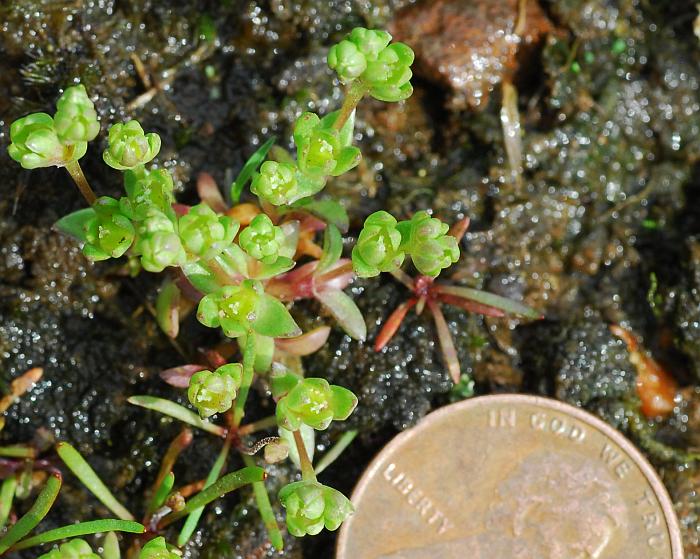Geocarpon minimum Mack.
Geocarpon

Native
CC = 10
CW = 5
MOC = 8
SRank = S2
GRank = G2
© SRTurner
Geocarpon minimum Mack.Geocarpon | |
 |
Native CC = 10 CW = 5 MOC = 8 SRank = S2 GRank = G2 |
© SRTurner |
|
Family - Caryophyllaceae Habit - Annual forb.
Stems - Loosely ascending to erect, 1-4 cm long, unbranched or few-branched, often appearing somewhat zigzag, glabrous.
Leaves - Opposite, fused basally into a cuplike sheath, sessile. Leaf blades 0.2-0.4 cm long, narrowly oblong to oblong-triangular, fleshy and often somewhat concave on the upper surface, truncate to slightly expanded toward the base, rounded or angled to a bluntly pointed tip. Inflorescences - Flowers appearing solitary or paired at the branch tips and solitary in the leaf axils, the stalks absent, the bracts apparently absent or (in terminal flowers) resembling leaves.
Flowers - Sepals 5, 3.0-3.5 mm long, fused into a cup-shaped or slightly flask-shaped tube, the tube 10-nerved, herbaceous to slightly succulent, green or reddish-tinged between the lobes, the lobes triangular-ovate, shorter than the tube, angled to a sharply pointed tip, often appearing slightly concave at the tip but not noticeably hooded or awned, the narrow margins thin and white. Petals absent. Stamens 5, the filaments distinct, attached to the calyx tube. Staminodes 5, minute and scalelike, alternating with the stamens. Pistil with 1 locule, sessile. Styles actually 3 but apparently absent, each with a stigmatic area along all or most of the inner surface.
Fruits - Capsules, 3.5-4.0 mm long, dehiscing apically by 3 minutely notched teeth. Seeds about 30, 0.3-0.5 mm wide, kidney-shaped, the surface with minute papillae or low tubercles, yellowish green to brown, lacking wings or appendages. Flowering - March - April. Habitat - Moist, sandy depressions in Channel Sandstone glades, sparsely vegetated slicks rich in magnesium and sodium. Origin - Native to the U.S. Lookalikes - Broadly, Androsace occidentalis. Other info. - This plant gives new meaning to the terms "tiny" and "inconspicuous." Many of its parts measure in the millimeters, testing the boundaries of traditional macro photography. The plant's unusual habitat requirements contribute to its rarity. In Missouri it has been reported from a cluster of 8 counties in the southwestern region of the state. Elsewhere it is only known from a few scattered populations in Arkansas, Louisiana, and Texas. It is listed as Imperiled in both state and Federal conservation rankings. Photographs taken at Bona Glade Natural Area, Dade County, MO, 4-6-2019 (SRTurner). |